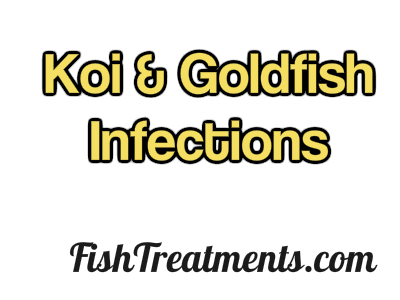
How To Treat Bacterial Infections in Ponds and Goldfish
There are special limitations in large facilities partly due to volume and partly because temperature isn’t always within our control.
There are at least two ways to “treat the pond” (and there fore the fish) when you can’t catch them up.
Bacterial Infections in Koi and Pond Fish | |
If you can't catch the fish and they have ulcers, consider serial treatments with potassium permanganate. This is especially good in cooler water, has a spectrum against ciliates like Costia and Chilodonella and may even destroy Fluke infestations. Dosing is better described elsewhere. See notes. | |
If you CAN catch the fish, consider injections of antibiotics for the valuable ones, iodine swabs on open wounds, and then water treatments (See remainder of this table) for uncatchable infected swimmers. | |
Scrubbing / debriding wounds in Koi depends on being able to "get through" slime and removing dead scales and NONWOVEN gauze is too slick. You need "Woven" gauze. Believe it or not, for HUMAN wounds it's undesirable. So it's CHEAPPPPPP. | |
Treatment with chloramine-T is potentially dangerous in the case of overdose. Dosing is beyond the scope of fish treatments website. If you're not sure about instructions in Dr Jill Spangenberg's notes, this might not be for you. | |
Antibiotic Baths | |
Soft rubber tanks | |
Aeration in the holding / bath tank | |
In holding, these sponge filters are soft on the Koi faces, (won't pick up eggs or fry) and they provide filtration AND aeration in one unit. They're cost-effective they BIOSEED very quickly. If you're using Lifeguard as a bath, forget bioseeding ha ha ha ha ain't no germ gonna live in the filter. Still, a soft, smushy 'airstone' is necessary. | |
Medicated Food | |
Oxolinic acid and Naladixic acid are antimicrobials related to the quinolone antibiotics. They're 'forgiving' on dosage when mixed with oil, or other binder to put on food. | |
Confectioner's Glaze | |
There is no contest between all of the above and injections of antibiotics. If the fish are valuable and you want top-notch results, you need to be injecting the fish with legitimate antibiotics from a prescribing veterinarian. | |